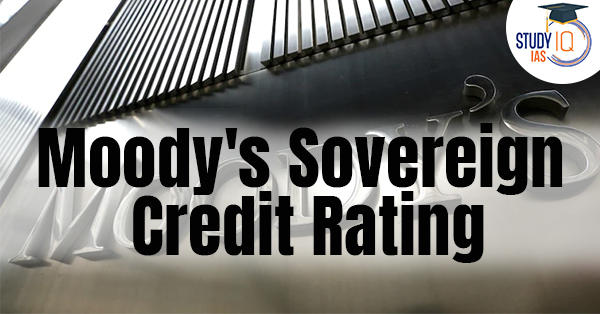Table of Contents
What is a Moodys Sovereign Rating?
- A Moodys Sovereign Rating is an independent assessment of the credit worthiness of a country or sovereign entity.
- It signifies the country’s ability to meet its debt obligations in the future.
- Moodys Sovereign Rating provides investors with information about the level of risk associated with investing in the debt of a particular country.
- Moodys Sovereign Rating, Several factors taken into account include debt service ratio, growth in its domestic money supply, its import ratio, and the variance of its export revenue.
- Apart from the economic environment, political risk is also taken into account.
- It helps countries in raising investment through external debt markets, as also to attract foreign direct investment (FDI).
What the Moodys Sovereign Rating Means for India?
- Moody’s considers a Baa3 or higher rating to be of investment grade, and a rating of Ba1 and below is speculative.
- India’s rating of Baa3 from Moodys Sovereign Rating signifies low risk of default and will help India get investment from foreign markets.
India by Numbers (Moodys Sovereign Rating)
- Expected rate of growth in current fiscal year: 7.6% in real GDP terms
- Current Account Deficit (CAR) to widen to 3.9% of GDP
- Fiscal deficit will see consolidation between 2022/23 and 2024/25 leading to debt stabilization at around 80% of GDP
- Similar rated economies have a median of 55% of GDP as debt.

A Stable Outlook of India:
- The Moodys Sovereign Rating agency has said that for India risks from negative feedback between the economy and financial system are receding, meaning the recent trend of high inflation and slow growth are subsiding.
- Banks and nonbank financial institutions (NBFIs) have higher capital buffers and greater liquidity. Thus, they pose much less risk to the sovereign than previously anticipated.
- These factors will facilitate the ongoing recovery from the pandemic.
- Moodys Sovereign Rating Agency says Global challenges including the impact of the Russia-Ukraine conflict, higher inflation and tightening global financial conditions are unlikely to derail India’s economic recovery.
- Few challenges of low per capita income, high general government debt, low debt affordability and limited government effectiveness remain. But the overall outlook remains positive in the future.
Will India see Ratings Upgrade in the Future?
The Moodys Sovereign Rating Agency has further noted that an upgrade may be seen if:
- India’s economic growth potential increase supported by effective implementation of economic and financial sector reforms.
- There is a significant and sustained pickup in private sector investment.
- There is an effective implementation of fiscal policy measures that results in a sustained decline in the government’s debt burden and improvements in debt affordability
Moodys Sovereign Rating: About India’s Banking Sector?
- The stressed assets of most public sector banks emerged from loans to businesses related to infrastructure, power and steel, originating between 2009-12.
- Strengthening consumer and business confidence and loan growth, as the economy gradually recovers from the pandemic will help support the operating conditions for banks.
- Banking system’s asset quality and profitability may improve in the future.
- Over the past year, Capital ratios for both private and public sector banks have improved.
- Capital ratios or Capital Adequacy ratio is the percentage of banks capital to its risk-weighted assets





















 WhatsApp
WhatsApp